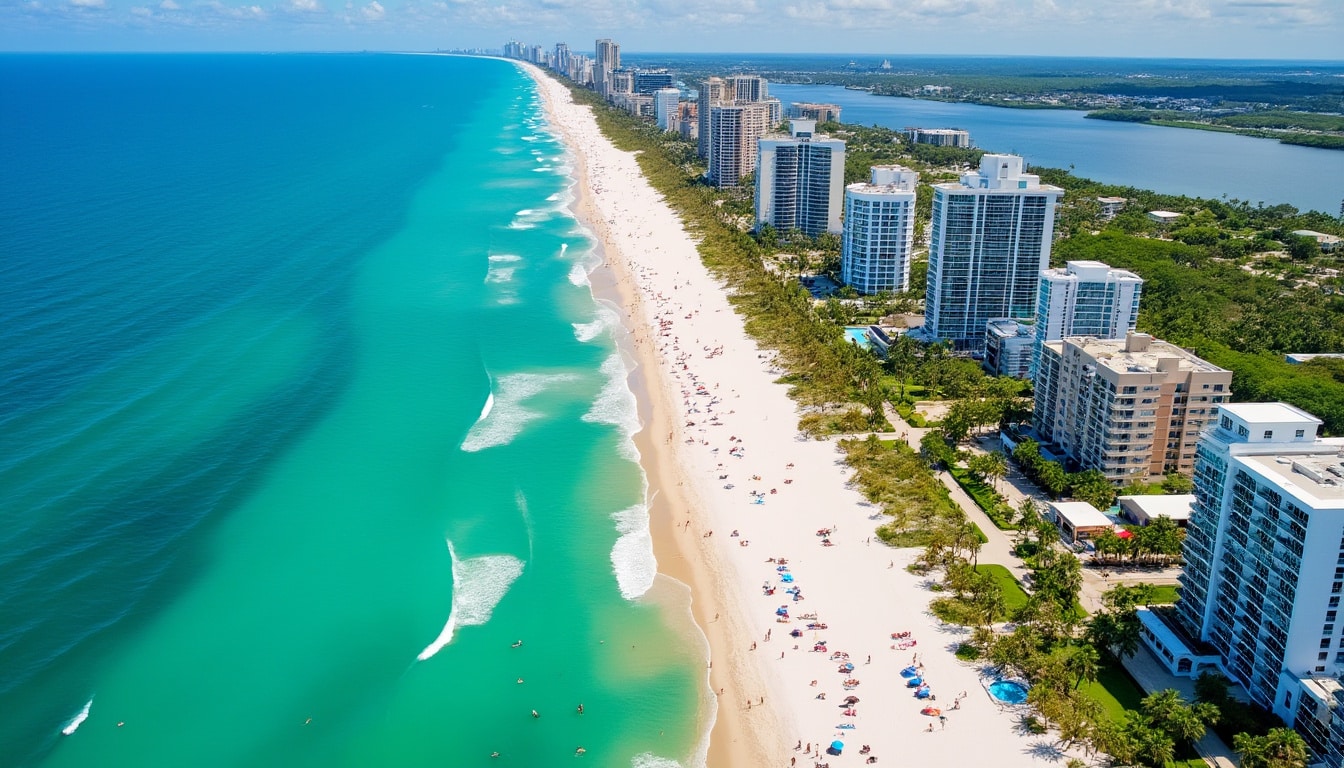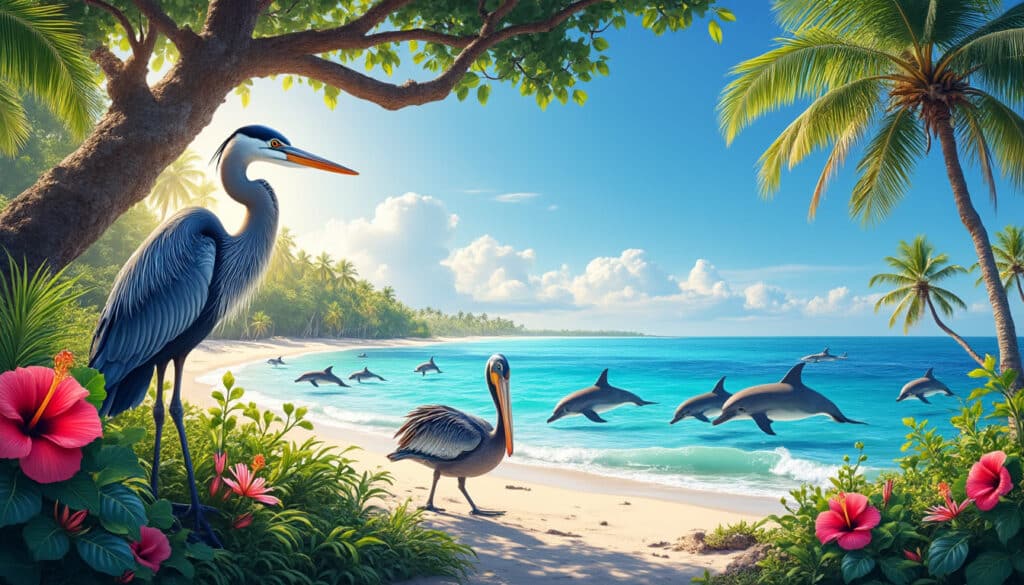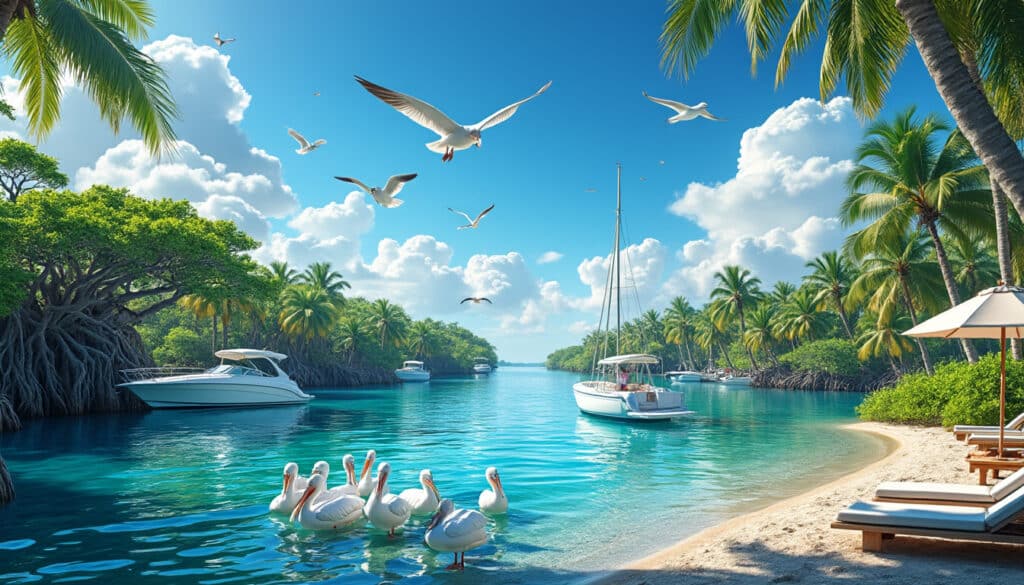Discover the myriad wonders of Fort Lauderdale, a jewel nestled in southeastern Florida. Known for its extensive waterways and golden beaches, this destination offers far more than a typical coastal city experience. It holds the unique charm of vast wetlands, vibrant wildlife, and cultural richness. Easily accessible from Miami, Fort Lauderdale is an appealing destination for travelers seeking both adventure and tranquility. This article delves into the varied natural landscapes and geographical features that define Fort Lauderdale, offering an exploration of its notable landmarks and natural beauty.
Geographical Location and Significance of Fort Lauderdale
Greater Fort Lauderdale, situated in Broward County, is a prominent area in southeastern Florida, strategically positioned amidst the bustling tri-county metropolitan region comprising Miami-Dade, Broward, and Palm Beach counties. Geographic coordinates place it between 25°58′ and 26°19′ latitude north and 80°0′ and 80°52′ longitude west, embedding it in a landscape defined by its accessibility and influence.
The county stretches approximately 50 miles wide and 27 miles long, a dimension that presents an array of diverse ecosystems. Along the eastern edge lies a continuous stretch of 27 miles of stunning beaches, running from Deerfield Beach to Hallandale Beach, offering an uninterrupted playground for sun-seekers and water sports enthusiasts. This accessibility makes Fort Lauderdale a pivotal point in South Florida’s maritime and recreational activities.
Moreover, the significance of its geographical location extends to its role as the second-most populous county in Florida, with an estimated population of nearly two million. This population concentration highlights Fort Lauderdale’s importance as a cultural and economic hub within the state. It also underscores the need for strategic urban planning and environmental management, given the county’s mix of developed lands and conserved natural areas.

Fort Lauderdale’s geography is notably flat, with the highest elevations being modern skyscrapers and beachfront hotels along Hollywood and Hallandale Beach. For those who venture to these heights, the panorama unfolds into a seemingly endless horizon, offering clear views without any natural barriers such as hills or mountains.
Surrounding Broward County are four other counties, each contributing to a greater network of connectivity and ecological diversity. To the north lies Palm Beach County, while Miami-Dade County sits directly to the south. Further west is Collier County, and to the northwest is Hendry County, framing Broward with eclectic cultures and landscapes.
- 🌴 Over 27 miles of pristine beaches await exploration.
- 📍 Positioned between Miami-Dade and Palm Beach counties, creating a central metro area.
- 🏗 Ranked as the 17th most populous county in the USA.
- 🗺 Supported by a network of waterways and canals, enhancing both utility and leisure.
The county is noteworthy not only for its geographic spread but also for its status as part of the “Conservation Area” of the Everglades, which occupies the western two-thirds of its expanse. This area is a protected zone ensuring the conservation of vital ecosystems and the native species that inhabit its territories. The geographical structure of Fort Lauderdale thus presents a dynamic interplay between urban development and nature conservation, creating an environment that is as much about preservation as it is about progress.
Urban Planning and Its Impact
In line with the growth and development of this geographical area, urban planning becomes a critical component. Professionals in urban planning navigate complex scenarios to ensure sustainable growth that balances the needs of housing, agriculture, recreation, and environmental conservation. The urban planning process in Broward County is pivotal for managing the demands of its growing population while conserving the ever-important natural landscapes and waterways.
Fort Lauderdale is a fascinating case for urban planners, as they must address the challenges of both developed cityscapes and expansive preserved areas. Urban planners here act as mediators between development and conservation, working to preserve the unique ecosystems while accommodating a modern, thriving populace.
The ongoing efforts in urban planning not only dictate the physical landscape of Fort Lauderdale but also its environmental health, economic vitality, and the overall quality of life for its residents. These efforts are further documented and regulated through legal frameworks ensuring a balanced pursuit of progress and preservation in 2025. For related information on urban legalities, read more about the legal landscape of Fort Lauderdale.
Exploring the Beaches and Waterways of Fort Lauderdale
Fort Lauderdale is often celebrated for its luxurious beaches and extensive canal systems, earning it the nickname “Venice of America.” The city’s coastline is adorned with stunning beaches that attract tourists globally, offering a perfect blend of serene escapes and vibrant beachside activities.
One of the distinguishing features of Fort Lauderdale is its Intracoastal Waterway, a network of navigable canals and rivers that crisscross the city. This waterway is instrumental in supporting marine transport, boasting some of the world’s most opulent yachts.
The beaches themselves, such as the iconic Fort Lauderdale Beach, are known for their fine sand and clear waters. Visitors can engage in a myriad of activities ranging from sunbathing and swimming to snorkeling and jet skiing. Additionally, the beachfront offers ample opportunities to enjoy local cuisine, with numerous eateries and beachfront cafes lining the famous Las Olas Boulevard.
- 🌊 Enjoy 24/7 access to Fort Lauderdale Beach.
- 🛥 Experience luxury along the Intracoastal Waterway.
- 🏖 Key areas include Las Olas Boulevard for shopping and dining.
- 🎉 Includes a host of recreational water activities.
A trip to Hugh Taylor Birch State Park offers a contrast to the bustling beaches, providing a tranquil escape into nature. The park presents lush, green walking trails, picnic areas, and the chance to canoe through freshwater lagoons. Visitors can explore its diverse ecosystems that reflect what Florida’s native landscapes would have looked like before extensive urban development.
Moreover, Fort Lauderdale’s beaches are pivotal in hosting various annual events that celebrate the local culture and community spirit. These shoreline events range from music festivals to food tasting expos, all contributing to the city’s vibrant social calendar. For some insight into Fort Lauderdale’s cultural ambiance, take a peek into what makes this city feel so unique.
Preservation Efforts
Stewardship of these natural assets is crucial in maintaining the ecological balance in Fort Lauderdale. There are numerous preservation efforts in place that aim to safeguard the coastal dunes, marine life, and water quality. Programs dedicated to beach cleanup, wildlife protection, and environmental education are instrumental acts carried out by both community-driven initiatives and governmental bodies.
In turn, this dedication to preservation is what sustains the appeal and magnificence of Fort Lauderdale’s beaches and waterways, assuring their splendor for future generations. Additionally, city guidelines and rules regarding beach use, such as those outlined in smoking and beach policies, are crucial in supporting these preservation efforts.
The Natural Charms of the Everglades
Just west of Fort Lauderdale lies one of the world’s most unique ecosystems — the Everglades National Park. Often referred to as the “River of Grass,” this expansive wetland is both a national treasure and a vital natural resource. Here, water currents persistently flow southward towards Florida Bay, nurturing a complex system of wetlands teeming with life.
The Everglades plays host to a diverse array of flora and fauna, captivating wildlife enthusiasts. Notable inhabitants include alligators, turtles, and a rich bird population that add to the park’s allure. Airboat tours offer an exciting way to explore this expansive “sea of grass,” bringing visitors face-to-face with its diverse ecosystems.
For those intrigued by cultural history, the Seminole Tribe calls the Everglades home and offers visitors a chance to learn about their storied heritage and connection to the land. This unique blend of cultural and natural significance makes the Everglades a must-see destination for anyone visiting the region.
- 🚍 Airboat tours provide an adventurous way to see the Everglades.
- 🐊 Home to wildlife such as alligators and the elusive Florida Panther.
- 🎒 Educational tours by the Seminole Tribe.
Beyond being a site of natural wonder, Everglades National Park is a crucial player in the environmental health of South Florida. The park acts as a flood buffer, helping to reclaim rainwater during the wet season, an essential role given Floridian weather patterns. Conservation efforts continue to be pivotal in preserving this natural wonder for future generations, highlighting its importance in environmental sustainability and eco-tourism.
Fort Lauderdale’s status as a gateway to the Everglades underlines its role in the broader ecological framework of South Florida. This proximity to the Everglades enriches the local flora and fauna, which contribute to the county’s biodiversity. Guided swamp tours, which take visitors through this enchanting landscape, showcase the park’s unique environment. Learn about how these tours balance adventure with conservation through the eco-guided tours.
Cultural and Historical Landmarks in Fort Lauderdale
Stepping beyond natural beauty, Fort Lauderdale is also replete with cultural and historical treasures. The Bonnet House Museum & Gardens is a celebrated landmark that fuses art, history, and nature. The plantation-style museum features art collections and picturesque gardens reflecting the area’s rich historical tapestry.
The city’s heritage is further embodied in the Fort Lauderdale Historical Society, which curates exhibits and offers insightful tours about the area’s development from its native history to modern-day. This organization plays a key role in preserving the stories that mark the evolution of Fort Lauderdale as a vibrant city.
The city also embraces a community of eclectic neighborhoods, each pulsating with character and local charm. From the bohemian ambiance of Las Olas Boulevard to the serene settings of Serenity Garden, Fort Lauderdale’s urban tapestry is dotted with places that reflect the region’s rich cultural diversity and history.
- 🎨 Bonnet House Museum & Gardens – A place where nature meets artistry.
- 🏛 Fort Lauderdale Historical Society – Keeper of the city’s past.
- 🌺 Serenity Garden – An urban oasis for contemplation.
Furthermore, the nightlife and dining scene in Fort Lauderdale is vibrant, with Las Olas Boulevard serving as a cultural playground offering everything from fine dining to local artisan shops. The Boulevard’s reputation as a vibrant cultural hub makes it a must-visit stretch for tourists looking to immerse themselves in the city’s urban delights.
All these cultural and historical sites interact to form a city that is as engaging and multifaceted as its physical environment. These landmarks not only add breadth to Fort Lauderdale’s narrative but also enhance its attractiveness as a tourist and residential destination. For additional insight into the social harmony of this diverse city, explore topics related to social dynamics in Fort Lauderdale.
Planning a Visit: Tips and Experiences
Visiting Fort Lauderdale offers a tapestry of experiences, shaped by its rich natural and cultural setting. Planning a trip involves exploring its wide array of attractions, each promising unique memories. A primary tip for visitors is to engage in the myriad water-based activities available, from canal tours to deep-sea fishing.
A visit to the renowned Fort Lauderdale Swamp Tours is highly recommended for nature enthusiasts keen on seeing the local ecosystem’s intricacies. Similarly, exploring the beaches, such as the bustling Fort Lauderdale Beach and the quieter Hallandale Beach, can cater to both action-seekers and relaxation enthusiasts.
For those interested in history and culture, visits to the Bonnet House Museum, Fort Lauderdale Historical Society, and strolls along Las Olas Boulevard provide a perfect blend of learning and leisure. The city’s various parks, including the Hugh Taylor Birch State Park, are ideal for those seeking a peaceful day out immersed in nature’s beauty.
For practical travel advice and understanding local customs, knowing about legalities of living in Fort Lauderdale can be highly beneficial, especially for visitors considering a longer stay or relocation.
| Activity | Location | Highlights |
|---|---|---|
| Beach Day | Fort Lauderdale Beach | Swimming, Sunbathing |
| Canal Tour | Intracoastal Waterway | Scenic Views, Luxury Yachts |
| Historical Tour | Bonnet House Museum & Gardens | Art Collections, Botanical Gardens |
| Swamp Tour | Everglades National Park | Wildlife Viewing, Airboat Rides |
| Shopping and Dining | Las Olas Boulevard | Local Cuisine, Shopping |
Ultimately, Fort Lauderdale presents a dynamic environment where visitors can embrace both its natural wonders and urban elegance. Whether the allure is in its tranquil beaches or the excitement of its urban and cultural hubs, Fort Lauderdale remains a captivating destination ready to be explored.
FAQ about Nature and Geography of Fort Lauderdale
- 🏝 What is the best time to visit Fort Lauderdale?
Fort Lauderdale is best visited in spring (March to May) when the weather is warm, dry, and hotels offer more available bookings. - 🛶 Are there guided tours available in the Everglades?
Yes, numerous guided tours offer visits to the Everglades through airboat rides and provide educational insights into the local ecosystem. - 🥽 What are the top activities to do on Fort Lauderdale Beach?
Popular activities include swimming, snorkeling, beach volleyball, and renting jet skis or paddleboards for water sports enthusiasts.

Geographical features of Fort Lauderdale
🏖️ Discovering Fort Lauderdale, often referred to as the “Venice of America,” opens up a world of geographical wonders. Nestled along the Atlantic coast, this vibrant Floridian city is renowned for its intricate network of canals, sparkling beaches, and diverse…

Location and coordinates of Fort Lauderdale
Discovering the dynamic blend of charming beaches, cultural hotspots, and modern landmarks in Fort Lauderdale makes it an appealing destination for both tourists and potential residents. Known as the “Venice of America,” this vibrant city has long intrigued travel enthusiasts…

Nature and wildlife in Fort Lauderdale
🌴 While many travelers flock to Fort Lauderdale for its renowned beaches and vibrant nightlife, the city’s natural wonders offer a surprisingly rich and diverse ecosystem for those seeking outdoor adventures. Nestled in the heart of South Florida, Fort Lauderdale…

Rivers and water near Fort Lauderdale
Fort Lauderdale, often dubbed the “Venice of America,” is a sun-drenched paradise renowned for its intricate network of rivers and waterways. With approximately 3,000 hours of sunshine each year, the city offers a treasure trove of aquatic adventures and scenic…

